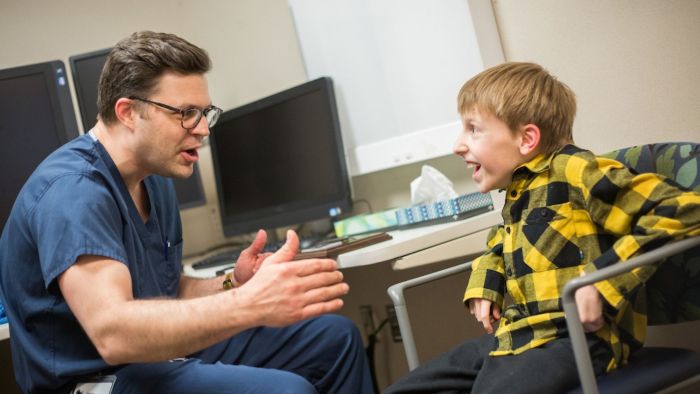Gillette Children’s has recently implemented BoneMRI, a groundbreaking imaging technology that combines bone and soft tissue imaging in one MRI scan, eliminating the need for traditional CT scans. Gillette is the first hospital in the United States to use this technology routinely in the clinical care of pediatric patients.
How BoneMRI Transforms Traditional MRI Imaging
With BoneMRI, three-dimensional, high-resolution CT-like images of bone are produced in a single imaging exam using conventional MRI scanners—which, up until now, have mainly been used to analyze soft tissue. The BoneMRI software seamlessly integrates with the normal MRI imaging process. Protected Health Information is removed, aside from indirect identifiers required for processing the data. Within minutes, the result is an MRI-derived CT-like image with sub-millimeter resolution.
Tenner Guillaume, MD, Pediatric Spine Surgeon and Chair of Gillette Children’s Spine Institute says the advantages to the technology are clear: “CT scans are often essential to a comprehensive understanding of our patients’ spines, and this is particularly true in the setting of congenital scoliosis, spondylolysis or for preoperative planning for spine surgery. However, traditional CT scans are associated with very high radiation exposures for our young, developing patients, and this has the potential to increase their lifetime likelihood of developing a neoplasm. With BoneMRI, we can obtain a synthetic CT image utilizing an MRI scanner, which eliminates radiation exposure altogether. This technology appears to be a game-changer when it comes to maintaining the radiologic principle of As Low As Reasonably Acceptable (ALARA).”
The technology works using an algorithm based on deep learning, a method of artificial intelligence inspired by the human brain. The algorithm is trained and extensively validated using real patient data.
Safer, More Convenient Care and Improved Results
Radiation from traditional imaging methods, like CT scans, can pose a health concern—especially for patients with complex conditions who require multiple scans over time. BoneMRI eliminates this risk by offering a radiation-free alternative. Visualizing both bone and soft tissue in a single scan can also reduce the number of imaging sessions, minimizing stress, time, and cost for patients and their families.
In addition, the precise and detailed images provided by BoneMRI offer better diagnostic information. Two images aligned are optimal for diagnosis, treatment planning and surgical navigation when information about both soft tissue and bone is required.
“In an effort to be at the vanguard of innovation in the pediatric spine community, we are heavy utilizers of customized 3D models of our patients’ spines. These models allow for detailed preoperative planning and increase intraoperative safety and accuracy in our complex spine surgeries. Historically, a CT scan has been required to create a high-resolution model of the spines upon which we will be operating” notes Dr. Guillaume. “But now we can get these high-resolution models without the use of any radiation whatsoever. BoneMRI is a game-changing technology and was an obvious investment for the Gillette Children’s Spine Institute as we continue to strive to maximize our patients’ safety by leveraging technology.”
Ongoing Innovation in Imaging Technology
BoneMRI is the most recent example of leading-edge imaging technology at Gillette focused on minimizing risk to patients and improving care. Gillette was one of the first in the nation to install an EOS Imaging System, which provides weight-bearing, low-dose images. EOS offers a lower dose of radiation, and the head-to-toe images help providers get a more accurate picture of a child’s natural, weight-bearing stance and alignment.
“As part of the Image Gently Alliance, Gillette is dedicated to providing safe, high-quality pediatric imaging. Putting patient safety, health, and welfare first by optimizing image quality while maintaining the lowest possible radiation dose to our patients is a top priority,” says Marty McLean, Manager of Imaging Services. “A large part of improving on this initiative is to constantly find and implement new technology. New technologies such as EOS and BoneMRI have helped reduce and eliminate the need for the level of radiation that was once necessary for obtaining high-quality imaging for our patients and providers.”
Solutions like BoneMRI and the EOS not only reduce the risks associated with radiation exposure but also streamline the imaging process, providing comprehensive and precise diagnostic information. As Gillette continues to implement new technologies, the goal remains clear: to enhance outcomes and deliver exceptional, patient-centered care.
 Home Page
Home Page



